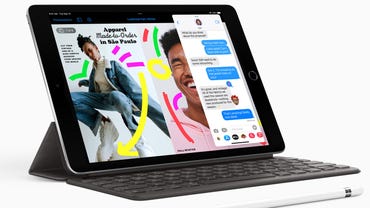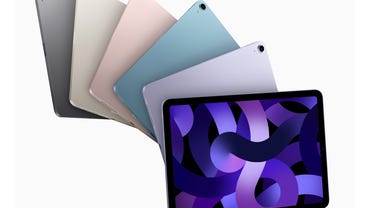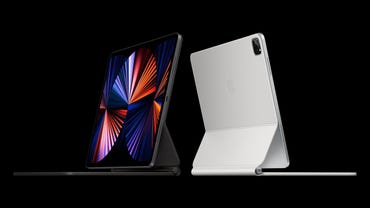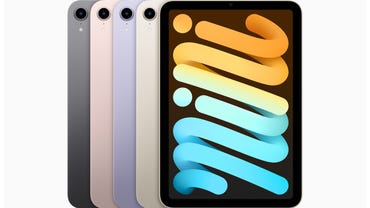[ad_1]
Apple’s iPad lineup is arguably something that’s unmatched by any other platform or tablet maker. With the recent announcement of the fifth-generation iPad Air, the entire lineup now has Apple’s fancy Center Stage FaceTime camera feature that keeps you framed in a video call at all times — seriously, it’s fun.
From the iPad Mini to the iPad Air or iPad Pro, the tablets all consistently find their way to the top of performance charts. They offer 10 hours of battery life, clear and crisp displays, and access to hundreds of thousands of apps in the App Store. On top of that, retailers regularly run iPad deals on the base model making it even more affordable.
With Apple continuously updating and adding features to iPadOS, the iPad keeps gaining valuable features like widgets on the homescreen, trackpad support and more Mac-like features, while differentiating the tablet lineup from the iPhone. You can even connect a mouse to an iPad Mini and use it as a miniature — and arguably more capable — netbook.
Below, you’ll find Apple’s iPad lineup and details about what differentiates each model in a bid to help you decide which iPad is best for you.
The base model iPad
Display: 10.2-inch Retina display | Processor: A13 Bionic | Storage: 64GB or 256GB | Biometrics: Touch ID | Colors: Silver, space gray | Cameras: 8MP rear, 1080p video. 12MP FaceTime camera with Center Stage | Weight: 1.07 pounds | Dimensions: 9.8 x 6.8 x 0.29 inches | Connections: 3.5mm headphone jack, Lightning port | Battery life: 10 hours
Apple’s tried-and-true tablet, the base model iPad, is arguably the best value out of the group. You get all of the same features as the more expensive Pro and Air models in a lightweight form factor with a 10.2-inch display.
Apple updated the iPad in the fall of 2021 with the A13 Bionic processor and new storage options doubling the previous offering to 64GB and 256GB, respectively. The entry-level iPad is perfect for students or someone who needs a tablet for watching their favorite Netflix shows and ordering groceries but doesn’t truly want it to replace their laptop.
Apple hasn’t expanded its facial recognition hardware beyond the iPad Pro lineup quite yet, and with the iPad Air and iPad Mini now without a home button, the ninth generation iPad is the only tablet left in the lineup with a home button with Touch ID. There is, however, a Smart Connector to add Apple’s Smart Keyboard, turning the iPad into more of a laptop than a tablet. And, of course, it supports the Apple Pencil.
Better yet? The iPad starts at $329, but you can often find iPad deals that bring the price down to $299 or cheaper. It’s incredibly powerful and even more affordable.
Pros
- Arguably the best value out of the group
- Has a Smart Connector and supports Apple Pencil
Cons
- Only iPad left with a home button
For (practically) everyone
Display: 10.9-inch Retina display | Processor: Apple Silicon M1 | Storage: 64GB or 256GB | Biometrics: Touch ID | Colors: Space gray, starlight, pink, purple, blue | Cameras: 12MP rear, 4K video. 12MP Ultra Wide camera | Weight: 1.02 pounds | Dimensions: 9.74 x 7.02 x 0.24 inches | Connections: USB-C port | Battery life: 10 hours
Apple’s latest update to the iPad Air is more of a catch-up announcement than anything. The fifth-generation iPad Air keeps the same design we saw Apple bring to the Air in late 2020, but it now boasts an M1 processor and 5G connectivity. That’s a lot of performance for the cost, which starts at $599.
The Air still sits confidently between the base iPad and the iPad Pro when you look at price, but it’s effectively caught up to the iPad Pro in terms of performance. But with a 10.9-inch display, a Touch ID sensor that doubles as a power button on the side of its housing, it’s more affordable and slightly different than the iPad Pro. The new iPad Air still works with the Magic Keyboard and second-generation Apple Pencil.
Apple also updated the color lineup for the Air, matching the iPad Mini’s color lineup, with the addition of a new blue color.
Where the iPad Pro is the model for those who want nothing but the best, the iPad Air is the model for those who want to use the tablet for work and play, without big sacrifices in performance or features.
At the $599 starting price, the iPad Air comes with 64GB or $749 for 256GB of storage. You can add cellular to it for an extra $130. For (practically) everyone, this is the iPad to get if you don’t want the base iPad, but don’t want to spend over $1,000 on an iPad Pro.
Pros
- Boasts an M1 processor and 5G connectivity
- Touch ID sensor that doubles as a power button on the side of its housing
- Works with the Magic Keyboard and second-generation Apple Pencil
Cons
- Same design we saw Apple bring to the Air in late 2020
As close as you can get to a laptop
Display: 11-inch Retina or 12.9-inch Liquid Retina XDR display | Processor: Apple Silicon M1 | Storage: 128GB, 256GB, 512GB, 1TB or 2TB | Biometrics: Face ID | Colors: Silver, space gray | Cameras: 12MP rear, 10MP ultra wide, 4K video. 12MP FaceTime ultra wide camera | Weight: 11-inch: 1.03 pounds 12.9-inch: 1.5 pounds | Dimensions: 11-inch: 9.74 x 7.02 x 0.23 inches, 12.9-inches: 11.04 x 8.46 x 0.25-inches| Connections: Thunderbolt/USB 4 port | Battery life: 10 hours
Apple’s 2021 iPad Pro lineup, unveiled in March, is by far the most capable and impressive iPad lineup we’ve seen. It’s also the most expensive, by a long shot. The design hasn’t changed all that much on the outside, but on the inside you’ll find Apple’s M1 processor. Yes, that’s the same exact processor that Apple is using in the MacBook Air and the 13-inch MacBook Pro.
We spent a lot of time with the 12.9-inch iPad Pro, and found it to be faster and more capable than any other iPad model we’ve tested to date. Another highlight of the larger iPad Pro is its Mini LED display that Apple calls Liquid Retina XDR, which is brighter and offer more color contrast.
The Thunderbolt 4 port enables faster syncing between the iPad and external storage devices, as well as more reliable connections to external monitors (hopefully in the future that means true external monitor support).
The Pro also supports the second-generation Apple Pencil, with a magnetic spot on the side to charge it. The Smart Connector is on the back of the iPad Pro, giving you the option to use it with the Magic Keyboard that includes backlit keys and trackpad, or Apple’s Smart Keyboard.
The iPad Pro, combined with iPadOS, is as close as you can get to a laptop without actually buying a laptop.
The 11-inch iPad Pro starts at $799 for the Wi-Fi model and $999 for the Wi-Fi + Cellular model, and the 12.9-inch iPad Pro starts at $1,099 for the Wi-Fi model and $1,299 for the Wi-Fi + Cellular model.
Pros
- On the inside you’ll find Apple’s M1 processor
- Faster and more capable than any other iPad model we’ve tested
- Close as you can get to a laptop without actually buying a laptop
- Thunderbolt 4 port enables faster syncing
Cons
- The most expensive, by a long shot
A brand new look
Display: 8.3-inch Liquid Retina display | Processor: A15 Bionic | Storage: 64GB or 256GB | Biometrics: Touch ID | Colors: Space gray, pink, purple, starlight | Cameras: 8MP rear, 1080p video. 12MP FaceTime camera with Center Stage | Weight: 0.65 pounds | Dimensions: 7.69 x 5.3 x 0.25 inches | Connections: USB-C | Battery life: 10 hours
If you want something smaller and more manageable, the iPad Mini fits the bill. Apple’s recent update to the Mini brought it current with the company’s new flat-edge design, a USB-C port for charging and data transfer, and support for the second-generation Apple Pencil. It’s powered by the A15 Bionic processor, and the display size was increased from 7.9-inches to 8.3-inches. By removing the home button and putting Touch ID in the top button that’s used to sleep/wake the tablet, the overall size of the Mini actually decreased.
There’s a spot on the right side of the tablet to charge the Apple Pencil, and it makes for a fantastic tablet to draw or write notes on.
You have the option of 64GB or 256GB of storage, with the former priced at $499 and the latter $649 for the Wi-Fi-only models. If you want to add cellular connectivity, you’re looking at a $150 increase. It’s smaller, but also more expensive, so unless you really value the size, you’re better off going with another iPad.
Pros
- USB-C port for charging and data transfer
- Support for the second-generation Apple Pencil
- Spot on the right side of the tablet to charge the Apple Pencil
- Touch ID in the top button
Cons
- If you want to add cellular connectivity, you’re looking at a $150 increase
- It’s smaller, but also more expensive
- Unless you really value the size, you’re better off going with another iPad
How did we choose these iPad models?
I’ve been testing and using tablets since the first iPad launched and have used every iPad on this list. The selection process for the best iPad consists of using the tablets myself, reading other reviews both from consumers and product reviewers, and then determining what should and shouldn’t make the list.
Which is the best iPad for you?
If you’re stuck between getting the base model iPad or the iPad Air (or for that matter, the Air or the Pro), I recommend sitting down and thinking of all the ways you want to use the iPad.
If your list primarily consists of consumption activities, such as watching videos and reading news, odds are the base model iPad is what you should go with. However, if you want to do a fair amount of emailing, messaging, writing, or web browsing, then the iPad Air is where your search should begin. As for the iPad Pro, it’s clear that it’s now meant for users who plan to push it to its limits, be it with connecting multiple accessories and monitors, or other peripherals while they work.
If you need a laptop replacement and like the iPad, then the Pro is where to start your search.
What are the differences between an iPad and an Amazon Fire tablet?
it’s easy to see the price difference between one of Amazon’s Fire tablets and an iPad and immediately write off the iPad. However, you have to remember that Amazon designs and builds its tablets as entry-level tablets that do the bare minimum. Performance is going to be slower, and app selection is going to be worse on Amazon’s Fire tablet lineup. The iPad has access to the same App Store the iPhone does, with most of those apps optimized to take advantage of the larger display in the iPad.
Who is the iPad Mini for?
Good question. It’s getting harder to find a justification for Apple to keep the iPad Mini in its tablet lineup, especially with Apple’s iPhone models getting bigger and bigger. The iPad Mini was recently refreshed, so Apple is still seeing some demand for it. My best guess is that the Mini is best suited for kids as learning and education devices, in an enterprise setting as payment kiosks and information stations, along with those who don’t like big phones or tablets but want a bigger screen for gaming and entertainment.
If I have a Windows computer or Android phone, will the iPad still work?
Yes, it’ll even sync with your Windows PC using iTunes. You’ll miss out on some features — such as iMessage — on your non-Apple devices, but you can still use an iPad without being all the way inside Apple’s walled garden. In fact, I know a lot of Android users who refuse to buy a Google-powered tablet because they prefer the experience on the iPad.
[ad_2]
Source link





